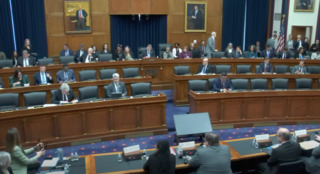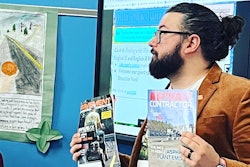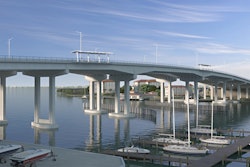
For the first time in history, an electric vehicle (EV) is the best selling vehicle in the world for 2023. The Tesla Model Y dethroned the long-standing king of car sales, the Toyota Corolla. While in the U.S. market, things look a bit different, with Ford's F-series trucks continuing to outsell every other make and model, two of Tesla's offerings are in the top 10. The Model Y hit number four in America through the final quarter of 2023. This is a milestone change in the North American car buying habits, but that's only half the story.
While it's true that EV cars are making news, the bigger reality that isn't making as many headlines is that the fastest selling electric vehicle in the U.S. are electric bikes. According to an article in Business Insider, by Tim Levin, "In dollar terms, e-bike retail sales nearly quadrupled in the past four years, rising from $240.1 million in 2019 to $885.5 million in 2022."1
These trends impact the primary product of the asphalt road building industry in a few ways:
- EV cars and trucks don't pay gasoline or diesel related taxes, essentially using federal roads for free
- If the funding problem is not resolved in such a way that shortfalls aren't met, it could mean fewer available dollars and less work for contractors
- EV cars and trucks are significantly heavier than their traditionally fueled counterparts, due to the size and weight of their batteries, which means they are putting more wear, tear, and stress on roads while not paying into the fund that maintains them
- This could result in complex changes in the way pavements calculate wear potential overtime, as well as overall resiliency
- E-Bikes, while they virtually place no strain on the physical integrity of roads, and actually contribute to a reduction in vehicle miles traveled (VMT) building infrastructure to support them requires planning and local support that can be sometimes difficult
Background on the Highway Trust Fund
The Federal Highway Administration's (FHWA) highway trust fund (HTF) gets its funding primarily through the taxes on fossil fuels. You pay it at the pump. These fund are what pay for the big infrastructure and road projects that make up a not-insignificant portion of contractors' state and federal work.
According to FHWA the HTF was created as a user-supported fund: highway users would pay taxes, the tax receipts would flow into the HTF, and HTF balances would be dedicated for use on highway projects (later expanded to surface transportation projects). This overall construct is still in place, but the tax structure has changed since the HTF year was created (1956).
The HTF has three long-standing sources of income:
- Federal fuel taxes
- Other Federal taxes on truck users
- Interest on invested balances
However, there's one big problem. These sources have failed to produce enough income to fully cover the expenses incurred for almost the past two decades. The last time gas taxes were increased was 1993. It's incredibly unpopular, borderline political suicide, to discuss increasing the gas tax. Yet, there is clearly a problem that must be addressed. The EV paradigm is here, and the HTF issues are only going to get more dire.
Another way of looking at this problem, is how the publicly owned road's construction and maintenance is currently entangled with a specific private industry through a consumption based tax. When this system was devised, you can see the initial logic: you need gas to drive the car on the road, so tax the fuel. In retrospect, this policy set in motion the current situation we are dealing with.
Jeff Davis, Senior Fellow, Eno Center for Transportation described how we got here like this, "It became a feature of federal energy and environmental policy to reduce the number of gallons of fossil fuel used on roadways. But it was still federal transportation policy to fund highways and transit based on the number of gallons of fossil fuel used on roadways. In effect, the separate federal policies have been at war with each other since the 1970s, and although it took a while, the Highway Trust Fund eventually paid the price."6
There is a complex system at work here, which is why solutions to the problem are not simple. the necessity of transportation and mobility (A) and the public good of federal and state roadways (B) became entangled with the success of the private fossil fuels industry(C). This three-point relationship is, in part, why making improvements to either party A or B that might contingently and negatively impact party C has an extreme uphill political battle. What does this relationship look like in practice?
In a prepared statement, excerpted here, U.S. Senator Sheldon Whitehouse (D-RI), Chairman of the U.S. Senate Budget Committee, said, "In the United States, by some estimates taxpayers pay about $20 billion dollars every year to the fossil fuel industry. What do we get for that? Economists generally agree: not much."2 Perhaps, that subsidy could be reappropriated to the HTF directly, it wouldn't solve the funding problem completely, but it wouldn't hurt? FHWA Table FE-1; CBO May 2023 HTF baseline forecast
FHWA Table FE-1; CBO May 2023 HTF baseline forecast
What Are The Options Here?
Highways and Transit Subcommittee Chairman Rick Crawford (R-AR) announced that the subcommittee would hold a hearing focused on the current solvency challenges associated with and the importance of a sustainable, long-term funding solution for the Highway Trust Fund. The hearing, entitled “Running on Empty: The Highway Trust Fund,” was held at October 18, 2023.
From Chairman Crawford's opening statement, "The Highway Trust Fund currently finances most federal government spending for highways, transit, and highway safety programs. Since 2001, however, spending from the Trust Fund has exceeded revenue deposited into the fund. Beginning in 2008, the Trust Fund has relied on a total of $275 billion in transfers, mainly from the General Fund of the Treasury, to remain solvent. Although critical to the Highway Trust Fund’s short-term operations, government bailouts are not a long-term solution, nor do they address the underlying, multifaceted, and structural problem."3
The hearing included statements from four witnesses, all who brought lengthy testimony from various pilot programs and multi-year research projects into alternative forms of funding road maintenance and repair. Some of the alternatives presented, with significant overlap, included:
- Road Usage Charge (RUC), which was conducted by Washington state, and is similar to other types of usage tax programs like Mileage Based User Fee (MBUF) or Vehicle Mileage Tax (VMT)4
- Increases to the existing taxes and fees to compensate for shortfalls5
- Set spending to maintain current highway conditions and performance, which would mean no capital spending for new highway construction or expansion5
- Simply continue to make general fund transfers, which is extremely unpopular, as indicated by the Chairman's remarks
- Dissolve the HTF, redirecting the existing tax receipts into the general fund, and require those programs previously covered to fight for their budgets through the same process as other programs6
- Create new, as yet undefined, taxes and/or fees and index their rates to inflation7
If We Do Nothing
Reading the statements from the four expert witnesses, as well as the remarks from Chairman Crawford, highlight just how bleak the next few years of being in the road building industry could be if nothing happens. Since the bipartisan infrastructure law was passed, many in our line of work have been eating well, but it might be the last time a legislative bandaid like that will work.
"According to the May 2023 Congressional Budget Office (CBO) baseline, annual HTF spending is estimated to exceed receipts by about $24 billion in FY 2028," said Kris Strickler, a member of the Board of Directors American Association of State Highway and Transportation Officials (AASHTO), as well as the Director for the Oregon Department of Transportation. Subcommittee on Highways and Transit, Wednesday, October 18, 2023Screenshot from the hearing: "Running on Empty: The Highway Trust Fund"
Subcommittee on Highways and Transit, Wednesday, October 18, 2023Screenshot from the hearing: "Running on Empty: The Highway Trust Fund"
Strickler continued, "If Congress were to reauthorize federal transportation programs for five years after the expiration of the IIJA just to maintain current investment levels from HTF adjusted for inflation, CBO estimates the gap between revenue into the HTF and expenditures from it would be roughly a staggering $150 billion."7
The status quo, and the idea of punting this thing further seems imprudent when faced with numbers like this. However, dealing with it head on is almost equally daunting. Davis put the two most seemingly possible scenarios into context during his testimony.
"Before 2021, I would have told you that the, 'abolish the Trust Fund,' scenario would leave the authorizing committees out of the funding process and put the Appropriations Committees in complete control," he said. "But a budget process could be established to allow this committee [Highways and Transit] and the Appropriations Committee to split duties for funding these programs out of general revenues. However, given the difficulty of getting eight-way unanimity between House and Senate Budget, Appropriations, tax-writing, and transportation policy committees to establish such a process, draconian spending cuts and/or huge tax increases might be an easier political lift."6
Ultimately, these decisions might seem a million miles away, and out of the reach of the industry itself, which heavily relies on this funding. However, involvement from the industry in the process makes a huge difference. Participating through the National Asphalt Pavement Association (NAPA), its meetings and political events, like the recent "Hill Days" which took place in Washington, D.C., and offered the opportunity to be in the room with some of the very people who do make these decisions.
The more that the industry works together, through NAPA or the State Asphalt Pavement Associations (SAPA) it increases the collective influence through important events like these, where the future is literally being decided upon. One thing is for certain, the future of the HTF won't be the same.




















